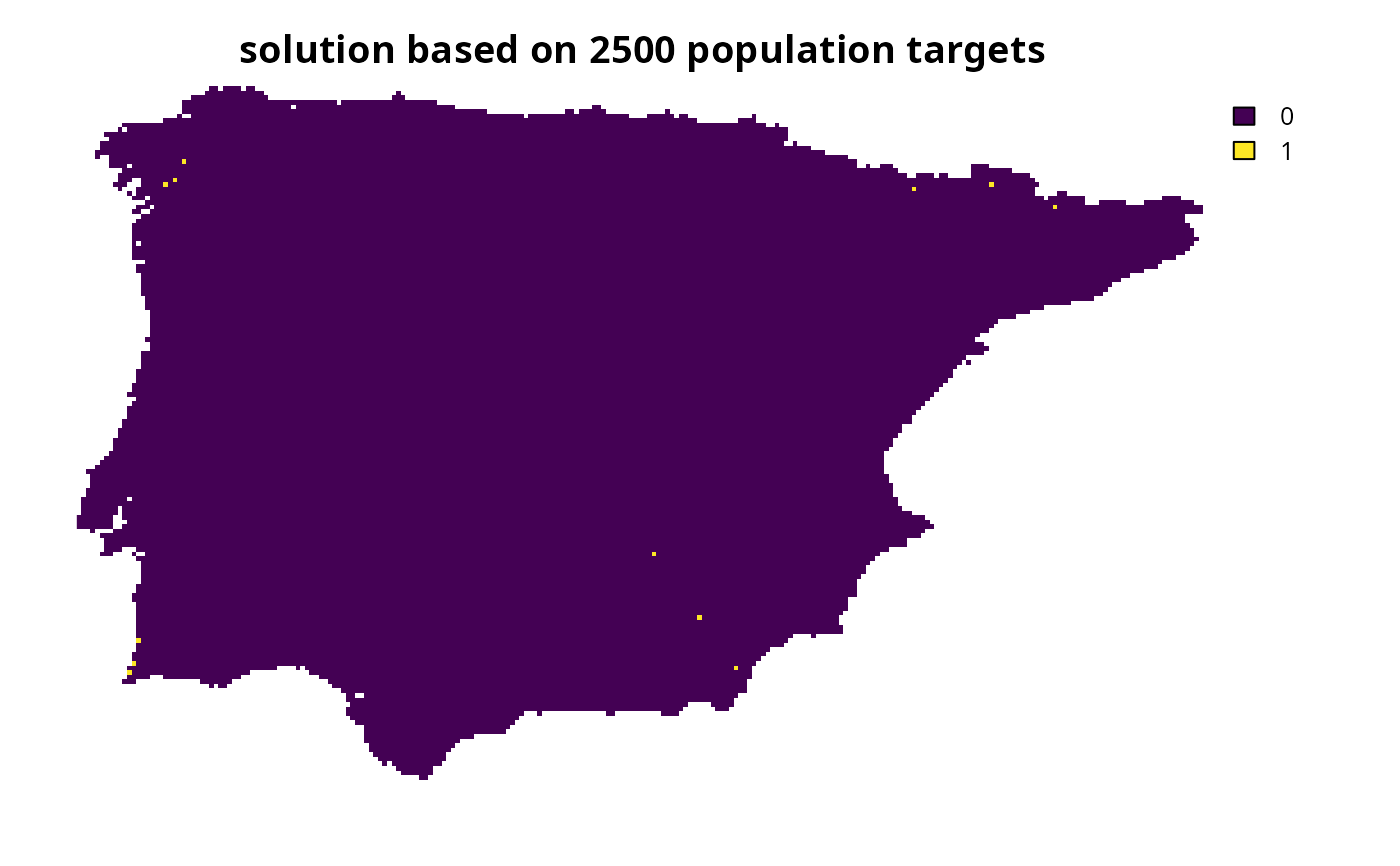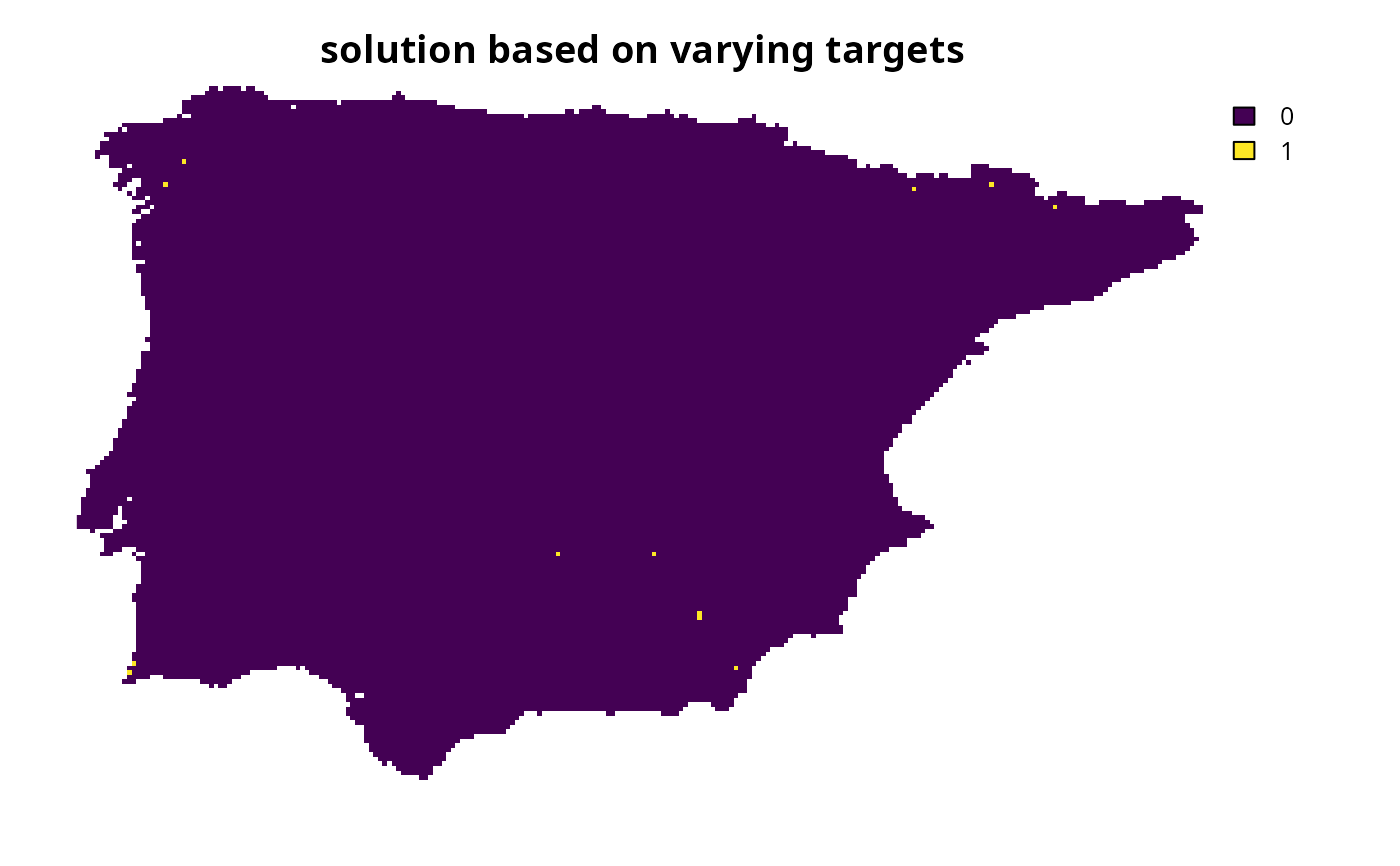Specify targets based on the minimum number of individuals for each
feature.
Briefly, this method involves using population density
data to set a target threshold for the minimum amount of habitat required
to safeguard a particular number of individuals.
To help prevent widespread features from obscuring priorities,
targets are capped following Butchart et al. (2015).
Note that this function is designed to be used with add_auto_targets()
and add_group_targets().
Usage
spec_pop_size_targets(
pop_size_targets,
pop_density,
density_units,
cap_area_target = 1e+06,
area_units = "km^2"
)Arguments
- pop_size_targets
numericvector that specifies the minimum population size required for each feature. If a singlenumericvalue is specified, then all features are assigned targets based on the same population size.- pop_density
numericvector that specifies the population density for each feature. If a singlenumericvalue is specified, then all features are assigned targets assuming the same population density. See Population density section for more details.- density_units
charactervector that specifies the area-based units for the population density values. For example, units can be used to express that population densities are in terms of individuals per hectare ("ha"), acre ("acre"), or km2 ("km^2"). If a singlecharactervalue is specified, then all features are assigned targets assuming that population density values are in the same units. See Population density section for more details.- cap_area_target
numericvalue denoting the area-based target cap. To avoid setting a target cap, a missing (NA) value can be specified. Defaults to 1000000 (i.e., 1,000,000 km2).- area_units
charactervalue denoting the unit of measurement for the area-based arguments. Defaults to"km^2"(i.e., km2).
Value
An object (TargetMethod) for specifying targets that
can be used with add_auto_targets() and add_group_targets()
to add targets to a problem().
Details
This target setting method can be used to set targets for species based on population size thresholds. Many different population size thresholds – and methods for calculating such thresholds – have been proposed for guiding conservation decisions (Di Marco et al. 2016). For example, previous work has suggested that the number of individuals for a population should not fall below 50 individuals to avoid inbreeding depression, and 500 individuals to reduce genetic drift (reviewed by Jamieson and Allendorf 2012). Also, the Red List of Threatened Species by the International Union for the Conservation of Nature has criteria related to population size, where a species with fewer than 250, 2,500, or 10,000 individuals are recognized as Critically Endangered, Endangered, or Vulnerable (respectively) (IUCN 2025). Additionally, the SAFE index (Clements et al. 2011) considers species with fewer than 5,000 individuals to be threatened by extinction (based on Brook et al. 2006; Traill et al. 2007, 2010). Furthermore, Hilbers et al. (2017) and Wolff et al. (2023) developed methodologies for estimating species-specific population sizes for protection based on population growth rates.
Population density
This method requires population density data expressed as the number of
individuals per unit area.
For example, if a species has 200 individuals per hectare,
then this can be specified with pop_density = 200 and
density_units = "ha".
Alternatively, if a species has a population density where one individual
occurs every 10 km2, then
this can be specified with pop_density = 0.1 and density_units = "km^2".
Also, note that
population density is assumed to scale linearly with the values
in the feature data. For example, if a planning unit contains
5 km2 of habitat for a feature,
pop_density = 200, and density_units = "km^2",
then the calculations assume that the planning unit contains 100 individuals
for the species.
Although the package does not provide the population density
data required to apply this target setting method, such data can be
obtained from published databases
(e.g., Santini et al. 2022, 2023, 2024; Witting et al. 2024).
Mathematical formulation
This method involves setting target thresholds based on the amount of habitat
required to safeguard a pre-specified number of individuals.
To express this mathematically, we will define the following terminology.
Let \(f\) denote the total abundance of a feature (i.e., geographic
range size expressed as km2),
\(n\) denote the minimum number of individuals that should
ideally be represented (per pop_size_targets), and
\(d\) population density of the feature
(i.e.,
number of individuals per km2,
per pop_density and density_units), and
\(j\) the target cap (expressed as
km2, per cap_area_target
and area_units).
Given this terminology, the target threshold (\(t\)) for the feature
is calculated as follows.
$$
t = min(f, j, n \times d)$$
Data calculations
This function involves calculating targets based on the spatial extent
of the features in x.
Although it can be readily applied to problem() objects that
have the feature data provided as a terra::rast() object,
you will need to specify the spatial units for the features
when initializing the problem() objects if the feature data
are provided in a different format. In particular, if the feature
data are provided as a data.frame or character vector,
then you will need to specify an argument to feature_units when
using the problem() function.
See the Examples section of the documentation for add_auto_targets()
for a demonstration of specifying the spatial units for features.
References
Butchart SHM, Clarke M, Smith RJ, Sykes RE, Scharlemann JPW, Harfoot M, Buchanan GM, Angulo A, Balmford A, Bertzky B, Brooks TM, Carpenter KE, Comeros‐Raynal MT, Cornell J, Ficetola GF, Fishpool LDC, Fuller RA, Geldmann J, Harwell H, Hilton‐Taylor C, Hoffmann M, Joolia A, Joppa L, Kingston N, May I, Milam A, Polidoro B, Ralph G, Richman N, Rondinini C, Segan DB, Skolnik B, Spalding MD, Stuart SN, Symes A, Taylor J, Visconti P, Watson JEM, Wood L, Burgess ND (2015) Shortfalls and solutions for meeting national and global conservation area targets. Conservation Letters, 8: 329–337.
Brook BW, Traill LW, Bradshaw CJA (2006) Minimum viable population sizes and global extinction risk are unrelated. Ecology Letters, 9:375–382.
Clements GR, Bradshaw CJ, Brook BW, Laurance WF (2011) The SAFE index: using a threshold population target to measure relative species threat. Frontiers in Ecology and the Environment, 9:521–525.
Di Marco M, Santini L, Visconti P, Mortelliti A, Boitani L, Rondinini C (2016) Using habitat suitability models to scale up population persistence targets for global species conservation. Hystrix, the Italian Journal of Mammalogy, 27.
Hilbers JP, Santini L, Visconti P, Schipper AM, Pinto C, Rondinini C, Huijbregts MAJ (2016) Setting population targets for mammals using body mass as a predictor of population persistence. Conservation Biology, 31:385–393.
Jamieson IG, Allendorf FW (2012) How does the 50/500 rule apply to MVPs? Trends in Ecology and Evolution, 27:578–584.
IUCN (2025) The IUCN Red List of Threatened Species. Version 2025-1. Available at https://www.iucnredlist.org. Accessed on 23 July 2025.
Santini L, Mendez Angarita VY, Karoulis C, Fundarò D, Pranzini N, Vivaldi C, Zhang T, Zampetti A, Gargano SJ, Mirante D, Paltrinieri L (2024) TetraDENSITY 2.0—A database of population density estimates in tetrapods. Global Ecology and Biogeography, 33:e13929.
Santini L, Benítez‐López A, Dormann CF, Huijbregts MAJ (2022) Population density estimates for terrestrial mammal species. Global Ecology and Biogeography, 31:978–994.
Santini L, Tobias JA, Callaghan C, Gallego‐Zamorano J, Benítez‐López A (2023) Global patterns and predictors of avian population density. Global Ecology and Biogeography, 32:1189—1204.
Traill LW, Brook BW, Frankham RR, Bradshaw CJA (2010) Pragmatic population viability targets in a rapidly changing world. Biological Conservation, 143:28–34
Traill LW, Bradshaw CJA, Brook BW (2007) Minimum viable population size: A meta-analysis of 30 years of published estimates. Biological Conservation, 139:159–166.
Witting L (2024) Population dynamic life history models of the birds and mammals of the world. Ecological Informatics, 80:102492.
Wolff NH, Visconti P, Kujala H, Santini L, Hilbers JP, Possingham HP, Oakleaf JR, Kennedy CM, Kiesecker J, Fargione J, Game ET (2023) Prioritizing global land protection for population persistence can double the efficiency of habitat protection for reducing mammal extinction risk. One Earth, 6:1564–1575.
See also
Other target setting methods:
spec_absolute_targets(),
spec_area_targets(),
spec_duran_targets(),
spec_interp_absolute_targets(),
spec_interp_area_targets(),
spec_jung_targets(),
spec_max_targets(),
spec_min_targets(),
spec_polak_targets(),
spec_relative_targets(),
spec_rl_ecosystem_targets(),
spec_rl_species_targets(),
spec_rodrigues_targets(),
spec_rule_targets(),
spec_ward_targets(),
spec_watson_targets(),
spec_wilson_targets()
Examples
# \dontrun{
# set seed for reproducibility
set.seed(500)
# load data
sim_complex_pu_raster <- get_sim_complex_pu_raster()
sim_complex_features <- get_sim_complex_features()
# simulate population density data for each feature,
# expressed as number of individuals per km^2
sim_pop_density_per_km2 <- runif(terra::nlyr(sim_complex_features), 10, 1000)
# create base problem
p0 <-
problem(sim_complex_pu_raster, sim_complex_features) %>%
add_min_set_objective() %>%
add_binary_decisions() %>%
add_default_solver(verbose = FALSE)
# create problem with targets to ensure that, at least, 2500 individuals
# for each feature are represented by the solution
p1 <-
p0 %>%
add_auto_targets(
method = spec_pop_size_targets(
pop_size = 2500,
pop_density = sim_pop_density_per_km2,
density_units = "km^2"
)
)
# solve problem
s1 <- solve(p1)
# plot solution
plot(s1, main = "solution based on 2500 population targets", axes = FALSE)
 # create problem with targets to ensure that a particular number of
# individuals for each feature are represented by the solution
# simulate the number of number of individuals required for each feature
target_pop_sizes <- round(
runif(terra::nlyr(sim_complex_features), 1000, 5000)
)
# now, create problem with these targets
p2 <-
p0 %>%
add_auto_targets(
method = spec_pop_size_targets(
pop_size = target_pop_sizes,
pop_density = sim_pop_density_per_km2,
density_units = "km^2"
)
)
# solve problem
s2 <- solve(p2)
# plot solution
plot(s2, main = "solution based on varying targets", axes = FALSE)
# create problem with targets to ensure that a particular number of
# individuals for each feature are represented by the solution
# simulate the number of number of individuals required for each feature
target_pop_sizes <- round(
runif(terra::nlyr(sim_complex_features), 1000, 5000)
)
# now, create problem with these targets
p2 <-
p0 %>%
add_auto_targets(
method = spec_pop_size_targets(
pop_size = target_pop_sizes,
pop_density = sim_pop_density_per_km2,
density_units = "km^2"
)
)
# solve problem
s2 <- solve(p2)
# plot solution
plot(s2, main = "solution based on varying targets", axes = FALSE)
 # }
# }
